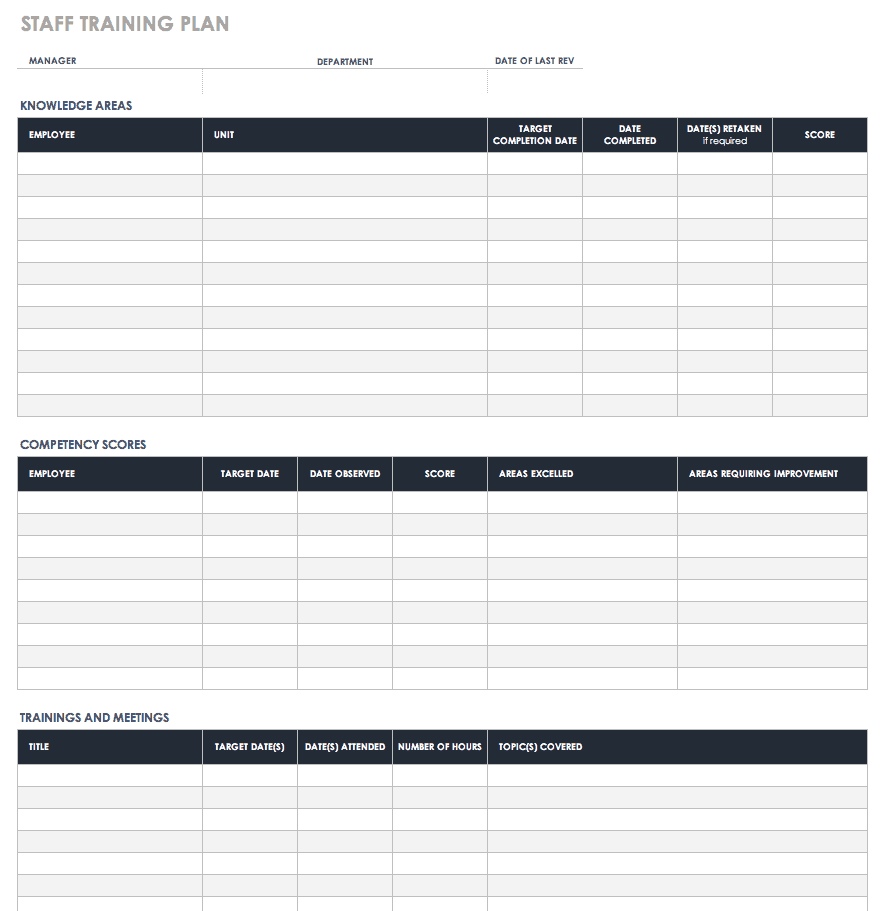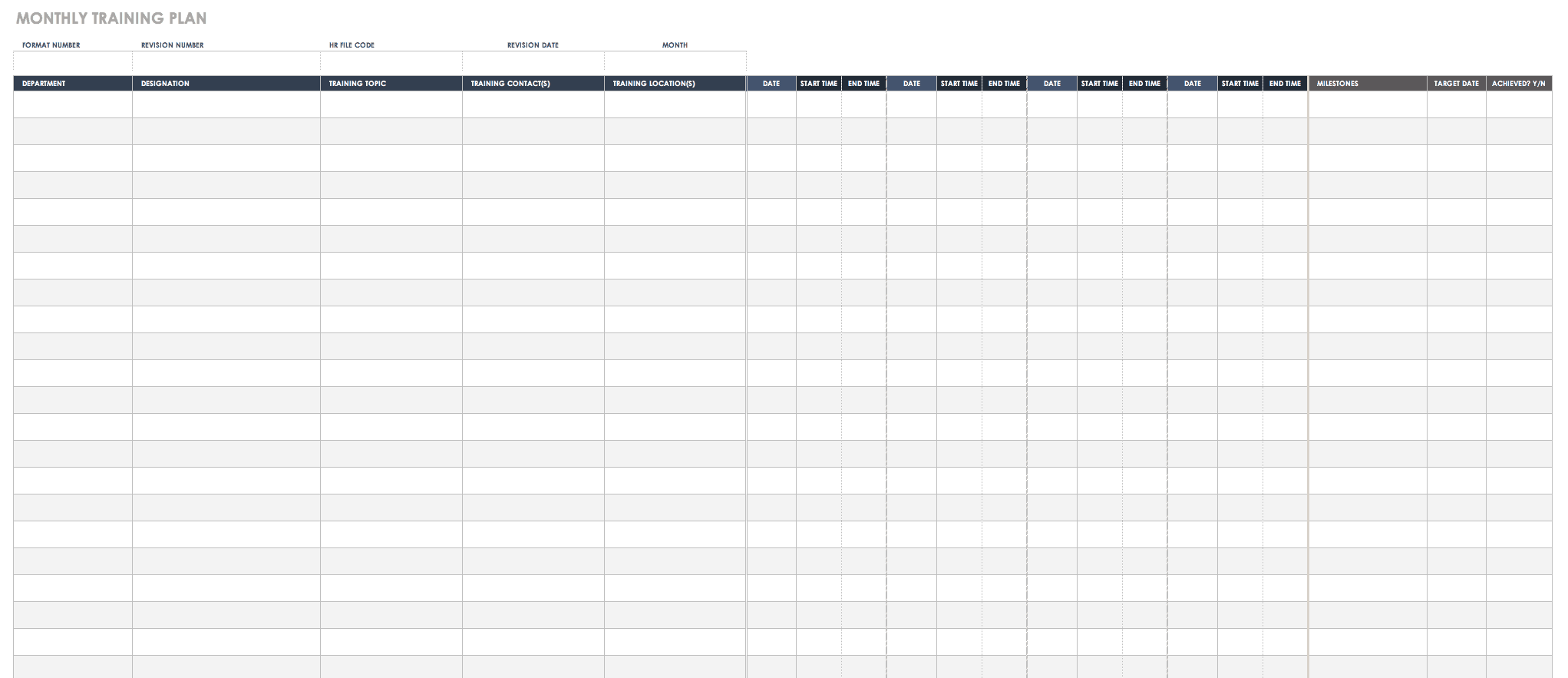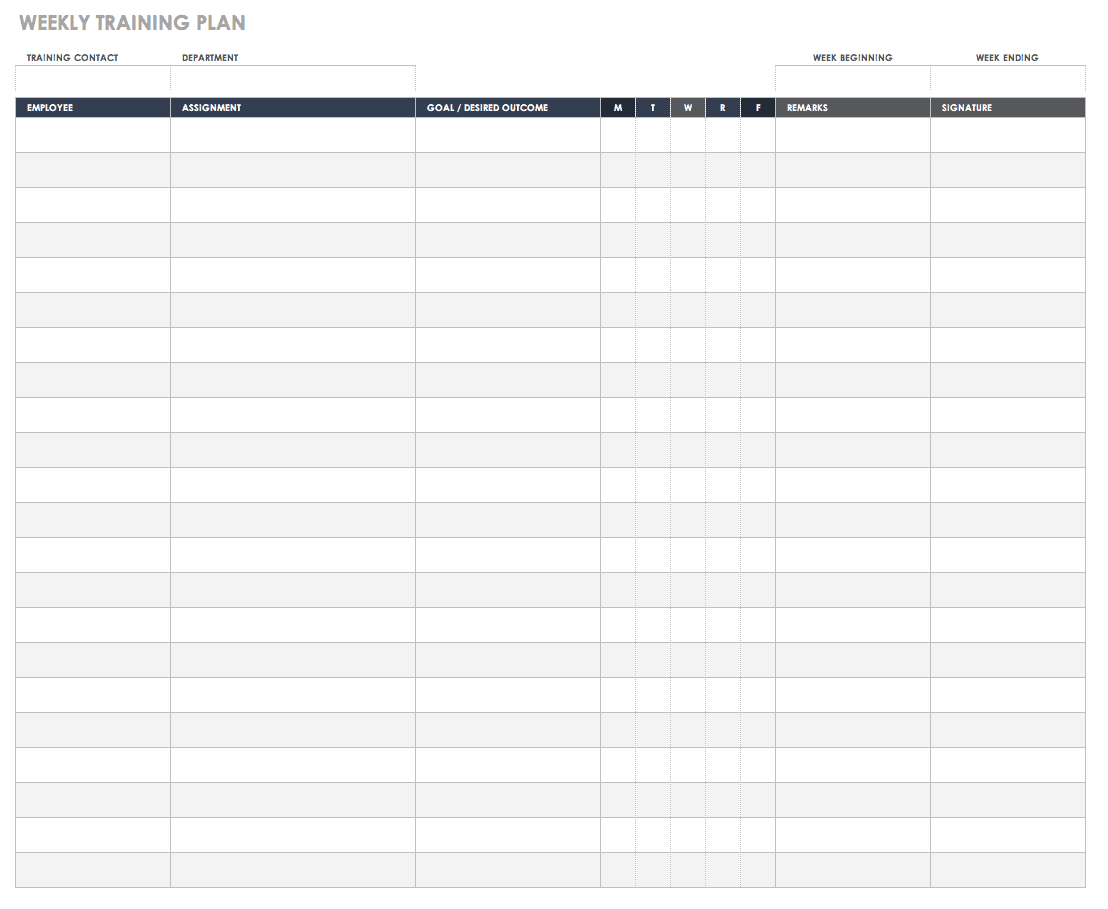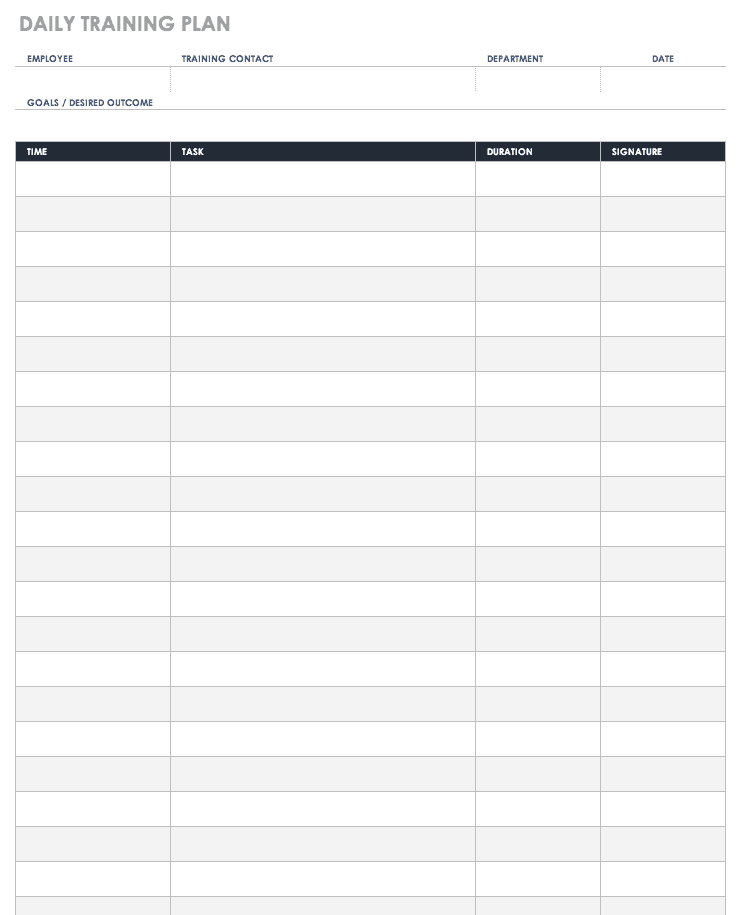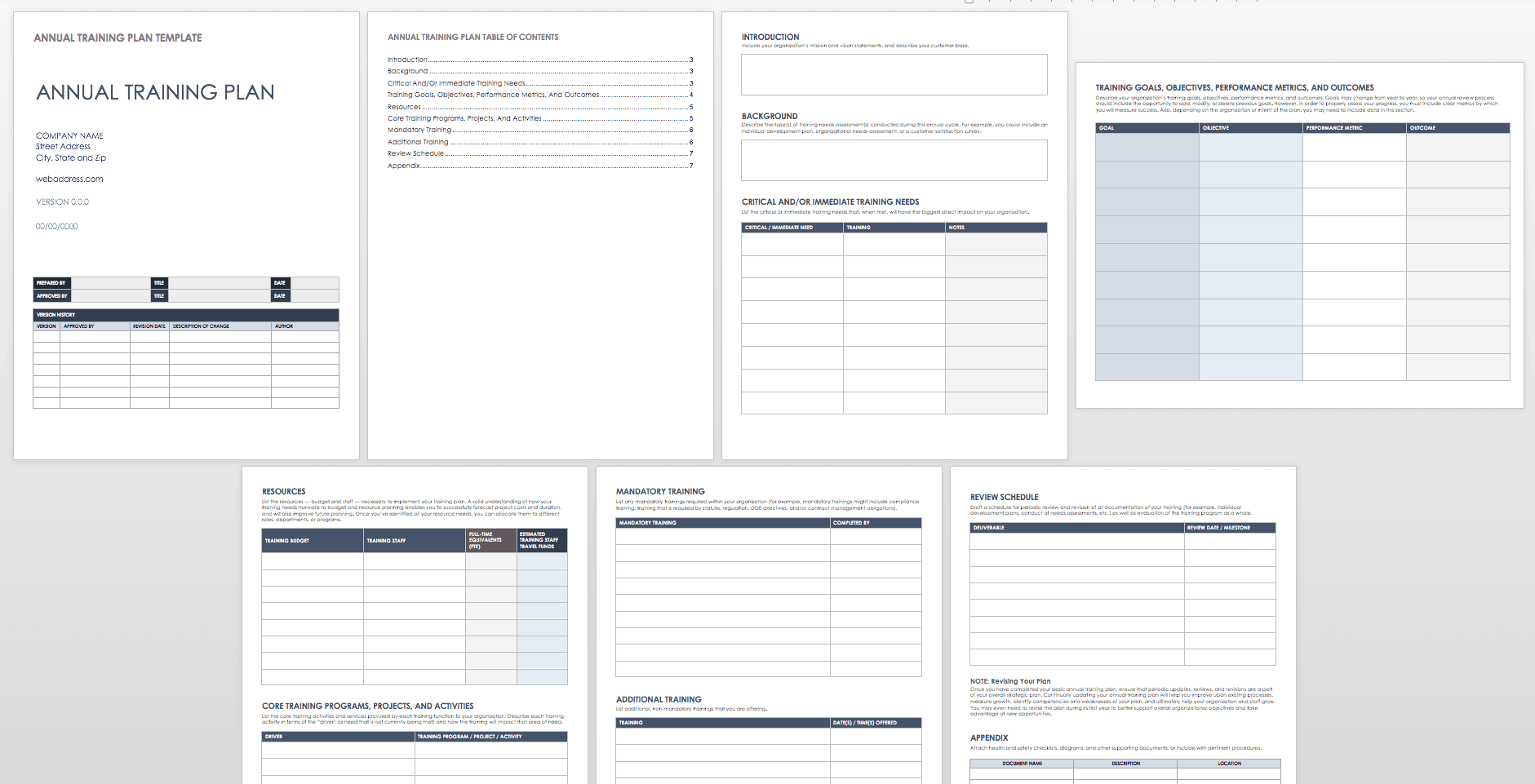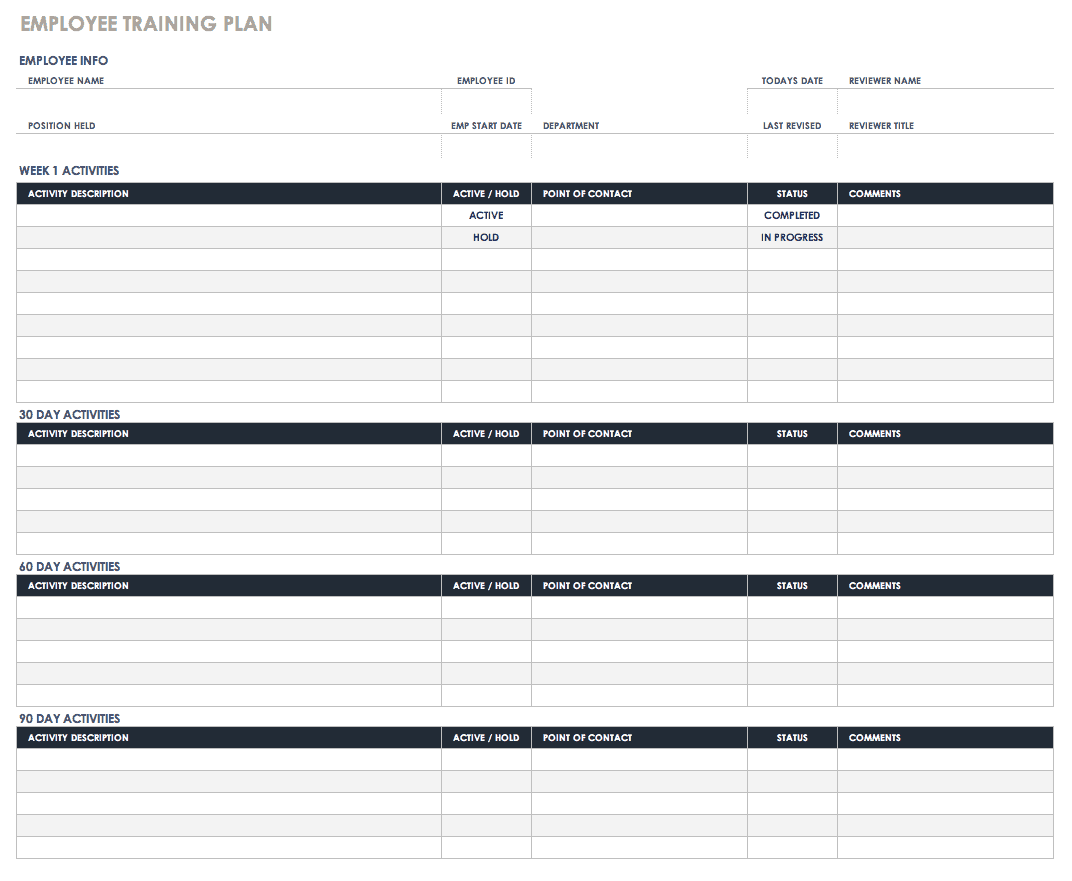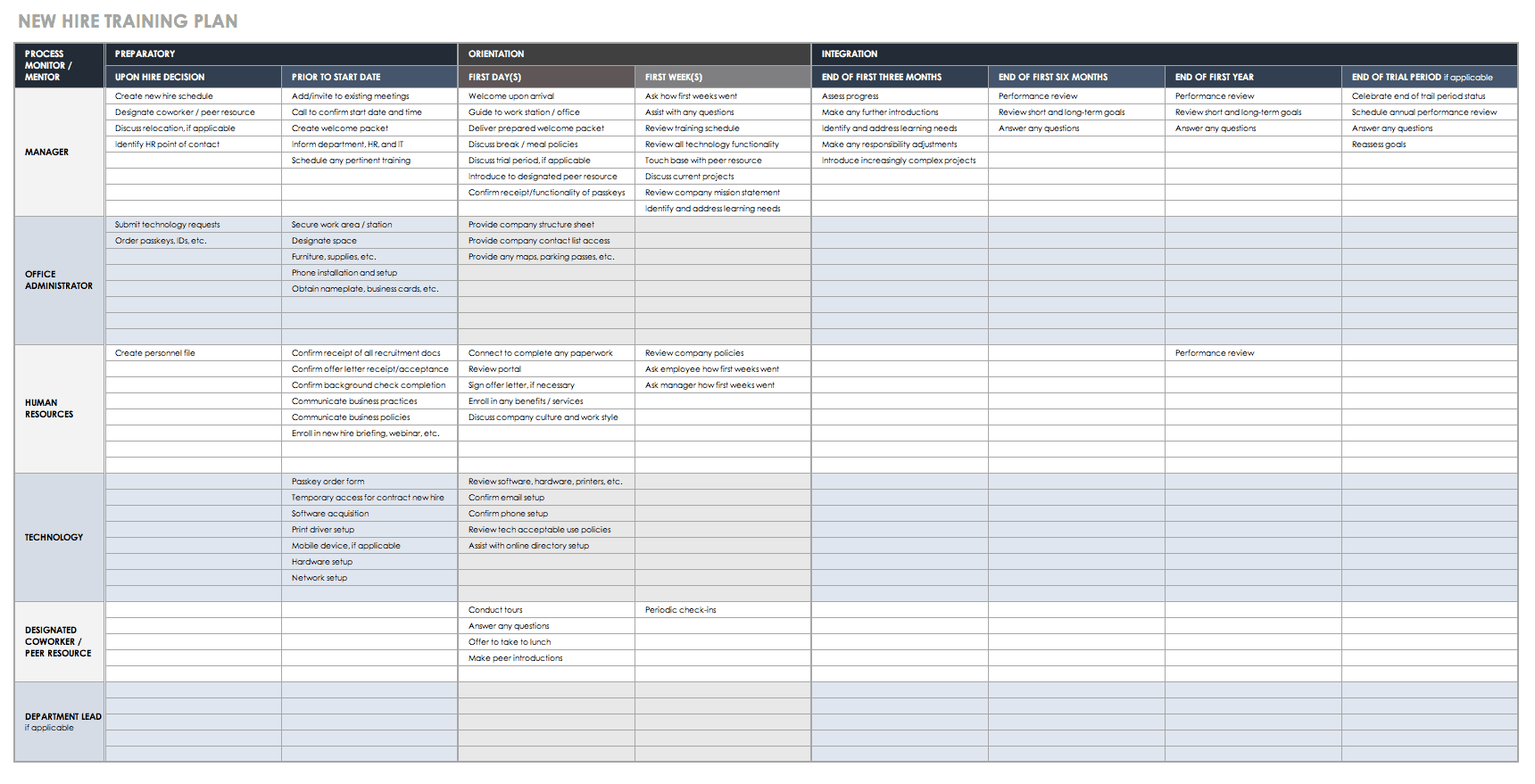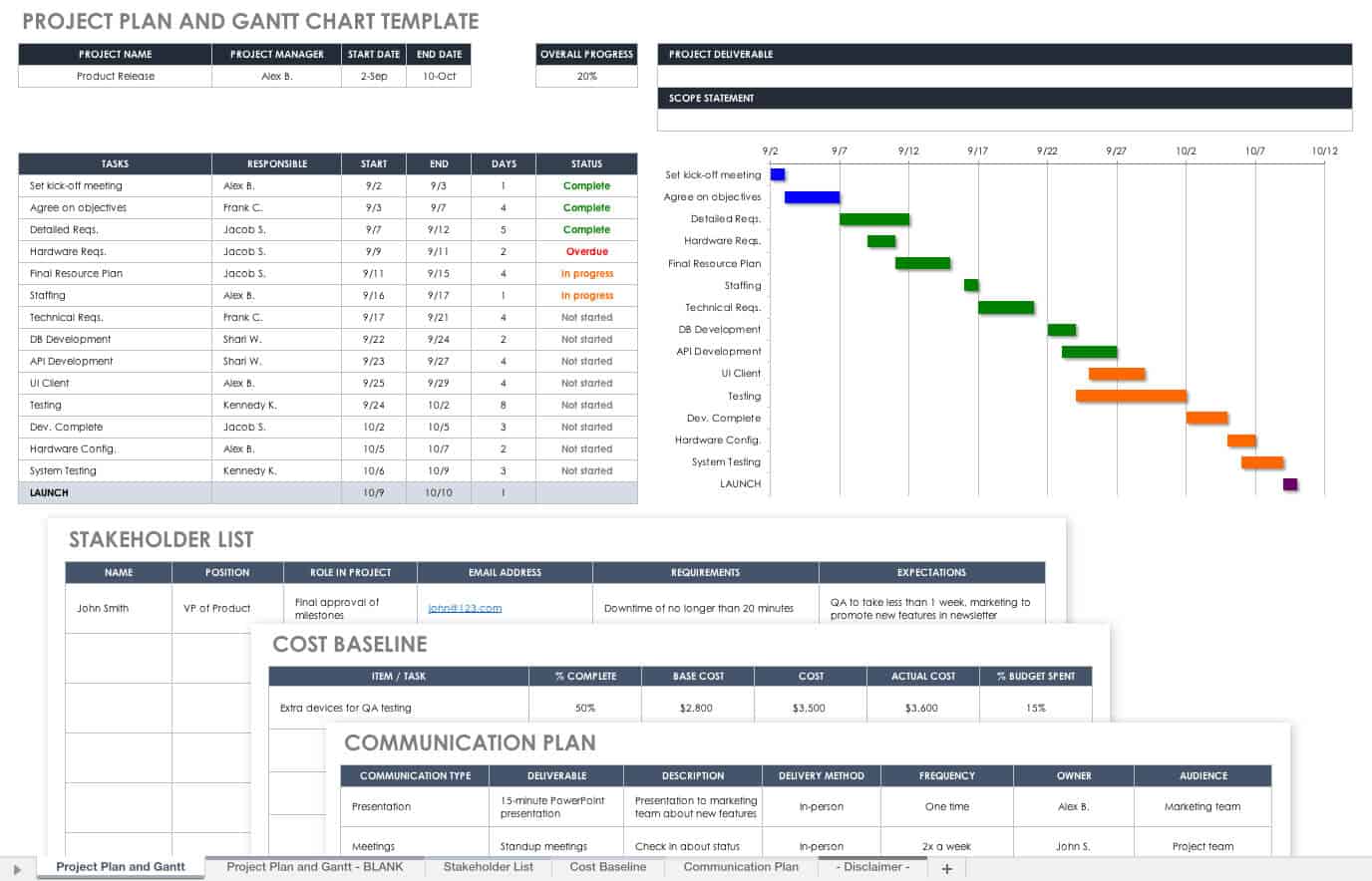Free Training Plan Templates
In this section, you’ll find training plan templates available in Microsoft Excel and Word formats, as well as PDF. Download all of the following templates for free, and customize them to meet your organizational needs.
Staff Training Plan Template
A team or department manager can use this template to document their entire staff’s progress at once. You’ll find multiple charts to track knowledge areas, award competency scores, and list formal trainings and meetings (as well as who has attended them or completed the necessary tasks). This template enables you to monitor both hard and soft skills so that you can get a composite view of each employee’s progress.
Monthly Training Plan Template
This template provides a useful schedule to help you plan your training over the course of a month. List details such as department, training contact, topic, and location, and then complete the prebuilt schedule with training dates and times. To track your progress, use the provided columns to mark milestones. Use this template as a high-level monthly planning tool to ensure you’ve organized training sessions and met your goals.
Weekly Training Plan Template
Download Weekly Training Plan Template
This simple training plan template is designed to track team or department progress on training activities over the course of a week. List the employee, activity, and desired outcome, and use the weekly calendar either to plan training sessions or to mark whether or not the employee completed the training work. Finally, leave remarks on each employee’s performance and sign off for approval at the end of the week. This template is especially relevant for a manager or a lead who needs to oversee multiple team members’ development over a short period of time.
Daily Training Plan Template
Download Daily Training Plan Template
Use this template to plan and track daily training tasks for a single team member. At the top of the template, list employee and training contact info, the department, and the goals or desired outcomes. In the chart below, list time, task, and duration of training, and sign each row as the employee completes an activity. Create a separate daily training plan for each team member to track their progress individually.
Annual Training Plan Template
This comprehensive annual training plan template is available as Word and PDF files. Create a narrative-style training plan with separate sections for background information, critical needs, goals, performance metrics, estimated budget, milestone schedule, and revisions. This template is best for teams that need to formally document their training efforts. For those who need a quick visual overview of progress, check out the simple annual calendar templates in this article.
Employee Training Plan Template
Download Employee Training Plan Template
Excel | Word | PDF | Smartsheet
Use this Excel template to create a training plan for an individual employee. List employee information, including ID number, position, department, and reviewer credentials, and then create a list of activities for Week 1, and for 30, 60, and 90 days out. The template includes columns for you to note whether the activity is active or on hold, the point of contact for each growth area, status, and observations — all of which will help you measure employee progress and keep them accountable.
New Employee Training Plan Template
Download New Hire Training Plan Template - Excel
This template is designed as an onboarding plan you can use to ensure new hires complete all the necessary training, paperwork, and activities as they acclimate to their new role. The template includes sections for activities completed through management, HR, IT, and peers, and it lists sample activities that a new employee might need to accomplish. Track the new hire’s orientation and integration from the first day through the first year with this easy-to-use template.
Project Plan Template
Download Project Plan Template - Excel
Sometimes, training can occur on the job. One way to ensure that you stay on track — in time, on budget, and within resources — is to create a project plan that outlines all the tasks, activities, and milestones you need to accomplish en route to your objectives or deliverables. Download this project plan template in Excel to list all tasks, assign team members and due dates, and note progress with the built-in Gantt chart, all the way through to project completion.
What Is a Training Plan?
A training plan is a document that details the strategy and specific steps needed to accomplish a goal or an objective. You can create a training plan for nearly any undertaking, such as a business or creative project, team development, staff or new hire training, or a personal endeavor (such as a running a marathon). Regardless of the objective, training plans hold you accountable for intentions, actions, tasks, or activities that must be completed en route to a larger goal.
Many different business roles can make use of a training plan, including trainers and instructors, managers, staff, employees, IT, support representatives, or the entire organization. Colleges and universities also frequently use training plans to track their progress toward a goal.
What Is a Training Action Plan?
A training action plan is a document that you create prior to the training plan, and lists only the actions necessary to achieve a particular goal. As opposed to a training plan, a training action plan does not include strategy or scheduling information. To learn more about action plans and to download action plan templates, read this article.
Benefits of a Training Plan
Building a training plan can help ensure the success of the project, onboarding, skill building, or other objectives you aim to achieve. By providing a road map to success, a training plan ensures that you accomplish tasks and meet milestones along the way to your overarching goal. In addition, a strong training plan can offer the following underlying benefits:
- Aid you in preparing objective, needs, strategy, and curriculum to be addressed when training participants
- Improve trainer and training participants’ experience by providing a clear plan of action
- Ensure that each training session is well planned, helpful, and inspiring
- Gain much needed expertise and experience, which can help you achieve your goal
Ultimately, these benefits can make it easier to accomplish your goals. Training plans play a vital part in making your organization more profitable, beating the competition, and creating a thriving work culture.
How Do You Design a Training Program?
Before you write your training plan, you’ll need to do some strategic thinking and create a program structure that reflects both the needs and abilities of your workforce and your goals. Designing a training program will vary based on the industry and type of undertaking, but some general tips can apply to any workforce training:
- Identify Training Needs: In order to design an adequate training program, you need to know your needs. Perform a training needs assessment in which you identify your goals, the tasks required to reach them, and the training activities that will support them.
- Set Learning Objectives: Once you have identified your needs, define what you want your workforce to achieve from an educational perspective. What do you want your employees to learn? How will you tangibly test knowledge growth?
- Create Training Materials: In most cases, providing your trainees with materials of some sort (be it physical or online documentation, or quizzes, games, etc.) will greatly enhance their learning and retention. Get creative and find useful ways to increase the “stickiness” of your training curriculum.
- Implement the Training Plan: Next, you have to execute the plan you’ve designed. Make sure to document progress, and note any problems or inconsistencies that arise. Use a training plan template (included above) to document and support implementation.
- Repeat Steps as Necessary: The goal of any training plan is to increase knowledge and skills, and you can’t rush the learning process. Take your time and ensure that everyone is getting the deep learning and practice that they need to be successful.
- Evaluate Training: This is a key element to the long-term success of your training plan. Elicit feedback from participants and managers, and refine your design for future use.
How Do You Write a Training Plan?
Just as the design of your training plan will vary based on your organization and specific goals, so will the documentation of your training plan. The templates included in this article offer a range of structures and styles, but you can customize all of them to fit your needs.
If you want to create your own document, here is a basic list of what to include in your written training plan:
- Objectives: List your goals, and make sure they are measurable and specific.
- Duration: Ideally, your training plan should be flexible, offer an approximate, realistic duration of the plan to give participants an idea of what to expect, and aid managers in evaluating performance. Some training plans include multiple future dates at which to measure performance (for example, 30, 60, and 90 days).
- Venue/Facility: If you are hosting a workshop, include details about the venue and facility, such as directions and special instructions.
- Dates/Times: If there are specific meeting times that staff needs to attend, make sure to list them on the plan.
- Activities and Learning Strategies: Depending on how comprehensive your training plan is, consider including a section where you detail the activities and knowledge areas in which you hope to see improvement. However, not all training plans require this level of detail.
- Milestones: Include room to mark key milestones, as well as space for dates and a signature if applicable. You might also want to include a section to rank accomplishments or competencies along the way.
- Approval Signature: Include a space for the manager or lead contact to sign off once the training program is completed.
Train and Retain Your Best Employees with Smartsheet for HR
Empower your people to go above and beyond with a flexible platform designed to match the needs of your team — and adapt as those needs change.
The Smartsheet platform makes it easy to plan, capture, manage, and report on work from anywhere, helping your team be more effective and get more done. Report on key metrics and get real-time visibility into work as it happens with roll-up reports, dashboards, and automated workflows built to keep your team connected and informed.
When teams have clarity into the work getting done, there’s no telling how much more they can accomplish in the same amount of time. Try Smartsheet for free, today.
